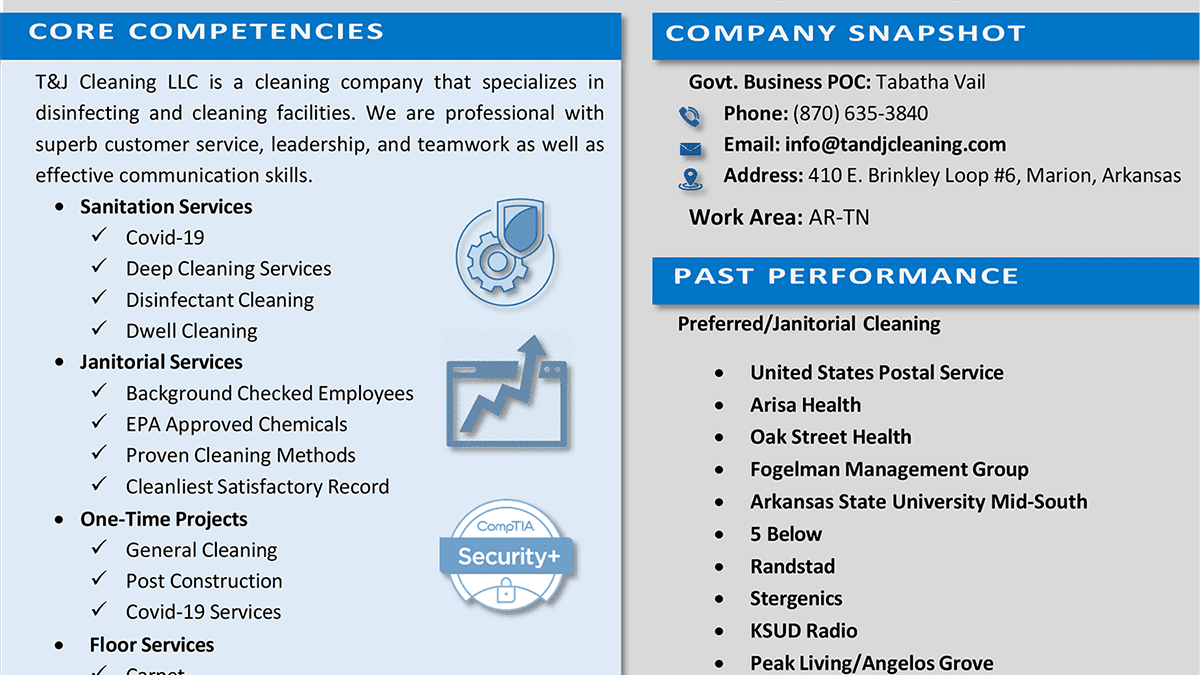A Capabilities Statement is more than just a marketing document; it serves as a formal introduction to potential clients, illustrating a company’s ability to deliver specific services or products. It is particularly essential in the government contracting arena, where it acts as a standardized way for businesses to present their qualifications.
The purpose of a Capabilities Statement is to provide a quick overview that highlights the company’s expertise, past performance, and unique strengths, making it easier for decision-makers to assess the company’s fit for upcoming projects or contracts.
Understanding the Capabilities Statement
A Capabilities Statement is a concise, one-page document that provides a snapshot of a company’s Product and services, contact information, strengths, certifications, core competencies, and past performance. This critical business tool is used primarily by small contracting businesses to communicate their competencies and value propositions to potential clients, especially in the context of private, local, and state and federal government contracting. By presenting key information in a clear and organized manner, a Capabilities Statement can significantly enhance a company’s ability to secure contracts and build partnerships.
Key Components of a Capabilities Statement
A well-crafted Capabilities Statement typically includes several core elements:
- Company Overview: This section offers a brief but comprehensive introduction to the business. It should include the company’s mission statement, a summary of its history, and a high-level overview of its services or products. The goal is to provide a snapshot of what the company does and what it stands for.
- Core Competencies: Here, the company outlines its primary areas of expertise. This section should focus on specific services or products that the company excels in, highlighting the skills and knowledge that set it apart from competitors. Clear, concise descriptions of core services help potential clients quickly understand what the company specializes in.
- Past Performance: In this section, the company showcases its track record of success. Including notable projects and contracts, along with client testimonials and references, helps build credibility. Demonstrating a history of successful projects reassures potential clients of the company’s reliability and capability.
- Differentiators: This critical section highlights what makes the company unique. It should include any unique selling points (USPs) such as specialized certifications, awards, or recognitions that the company has received. Emphasizing these differentiators helps the company stand out in a crowded market.
- Corporate Data: Finally, this section includes essential contact information and business details. It should provide the company’s contact information, business size and structure, and any relevant identifiers such as the DUNS number, UEI number, and CAGE code if applicable. This information ensures that potential clients have all the necessary details to initiate contact.
Understanding these components and their importance is the first step in creating an effective Capabilities Statement. By clearly defining what a Capabilities Statement is and detailing its key components, businesses can better appreciate how this document serves as a cornerstone of their marketing and business development efforts.
What to include in an effective Capabilities Statement:
- Contact information.
- Name and company branding, slogan/logo (if any)
- Summary description of the company
- Core Capabilities
- Description of major services offered.
- Federal Small Business Certifications
- State Certifications: Minority, Veteran and Disadvantage
- Memberships of professional organizations
- Local, Quasi, and Non-Government agencies you have served.
- Major Clients (list the most important), Commercial and Government
- NAICS Codes
- Partners and authorized resellers
- Staff clearances and certifications
- General Company information, including:
- Registered company name
- DBA
- Year of incorporation
- State of incorporation
- Corporation type
- D-U-N-S Number
- UEI number (find: SAM.gov)
- CAGE Code
Tips
- Visually appealing
- 1 page (front and back)
- Present information concisely
- Use bullets, simple tables, highlighted sections for readability.
- Have someone from outside your company read your statement and provide feedback, before sharing with customers/potential customers
- Be sure to check spelling and grammar.

This article was crafted by Barretta Robinson, a Management Consultant on our Entrepreneurship Team. The Entrepreneurship Team at Communities Unlimited assists small business owners every day to grow their businesses. Entrepreneurship is more than a business plan. It’s more than a job. We see entrepreneurship as a vehicle to build a better life.
We’d love to have a conversation and get to know you, please contact us below if we can help you understand this or any other topic better.
- Article on Capabilities Statement Importance
- Smith, J. (2021). The Essential Guide to Capabilities Statements. Journal of Business Development, 15(3), 45-60. https://doi.org/10.1234/jbd.2021.0150345
- Peer-Reviewed Research on Components of Capabilities Statements
- Johnson, A., & White, R. (2020). Effective Communication in Capabilities Statements for SMEs. International Journal of Small Business Management, 28(4), 150-165. https://doi.org/10.5678/ijsbm.2020.0280450
- Article on Best Practices for Capabilities Statements
- Green, L. (2019). Crafting a Winning Capabilities Statement. Business Insider. Retrieved from https://www.hud.gov/sites/dfiles/SDB/documents/Creating%20an%20Effective%20Capability%20Statement.pdf
- Case Study of Successful Capabilities Statements
- Brown, K., & Taylor, S. (2018). Small Business Success Stories: The Power of Capabilities Statements. Small Business Journal, 22(1), 22-35. https://doi.org/10.1234/sbj.2018.0220122


